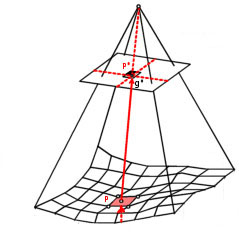Vr Mapping |
ON-LINE REFERENCE DOCUMENTATION CARDINAL SYSTEMS, LLC |

VrOrtho is a standalone program that generates digital orthophotos from aerial photography.
The software is powerful, able to process small jobs interactively or large jobs in batch mode. When VrOrtho is used in conjunction with VrOne, integration of Digital Terrain Model data is seamless and transparent. Results of the orthophoto process are easily reviewed in VrOne. VrOrtho keeps the Vr Mapping Software tradition by offering a user-oriented, easy-to-use orthophoto production package. An intuitive work flow may be maintained with project management and image status features.
This application creates ortho rectified images from multiple raw input images. VrOrtho accepts TIFF, JPEG, MrSID, and JPEG200 image formats as input and outputs images in TIFF or JPEG format.
The ortho rectification process consists of transforming standard perspective images without uniform scale into geographically referenced images with the perspective removed to provide uniform scaling. The ortho images contain geographic referencing in the form of TIFF world files with a .tfw extension, GeoTIFF tags inside a TIFF file, or JPG world files with a .jgw extension. The world files and GeoTIFF tags contain the ground coordinates of the upper left corner of the image and a pixel size in ground for the X and Y directions. When used on a standard aerial mapping job, the ortho process results in a series of overlapping ortho images. A mosaicing application, like VrMosaic, can then tie the orthos together into a seamless image mosaic.
In order to perform the ortho rectification process, VrOrtho must have a DTM ground surface for the area to be rectified and must have images that have been fully oriented. The DTM ground surface may be computed from standard VrOne vector files containing points and break lines or be loaded from a VrOne surface file. If the DTM ground surface is specified as a VrOne vector file with points and break lines, the surface is computed as necessary directly from the VrOne file(s). If a surface file is used, the surface is loaded directly from the file, potentially saving a great deal of processing time.